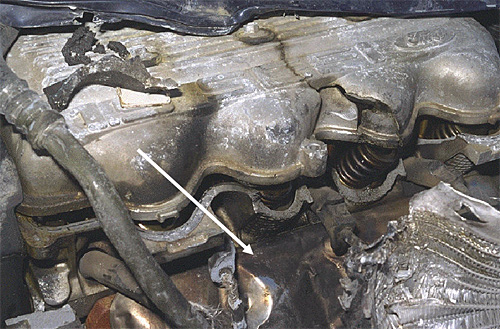Case Study: 1995 Ford Escort
Ignition and Propagation
Case Study: 1995 Ford Escort
Ignition and Propagation
Ignition: The shielded manifold provided the most likely ignition source; it was contacted by both oil and coolant. It is likely that the shielded exhaust manifold was hot enough to ignite oil; heat damage was restricted to this region of the engine compartment. Electrical arcing from the alternator, adjacent to the fire zone, was also possible. The alternator was broken off its mounting bracket, and its case was cracked. Impact-damaged ignition (spark plug) wires, in the vicinity of the fire, and at least two other broken or disconnected wires in the right front of the engine compartment could also have provided an ignition source through sparks or resistance heating.
In this instance, the burn damage was evident in the region of the shielded exhaust manifold and autoignition was a continuously available source of ignition. The alternate electrical sources of ignition would have sparked for short periods of time, intermittently and in remote areas not necessarily in the region of burn damage; therefore they were determined to be less likely sources of ignition than the hot exhaust manifold. It is also possible that oil and coolant vaporized on the manifold, creating a vapor generally in the engine compartment which was ignited by an electrical spark. If that was the case, the fire would then have flashed to the manifold as the source of the vapor and continued to burn there.
 Burn damage was limited to the area of the exhaust manifold under and around the heat shield (white arrow). Some soot was present on the cam cover as well. (see larger photo) |
Propagation: The fire most likely originated on the right front of the engine, on or near the exhaust manifold. Oil and/or coolant likely leaked between the exhaust manifold and shield. The fire did not spread beyond the small zone at the right front of the engine. Damage was limited to oxygen sensor wiring, the top of the right radiator tank (plastic) and the spark plug wires for cylinders 1 and 2. Witnesses described the fire as small, "like an oil lamp," that dripped burning material from the engine compartment to the ground below. The fire was observed within 2 minutes of impact and apparently burned for five to ten minutes before it was extinguished with a fire extinguisher.